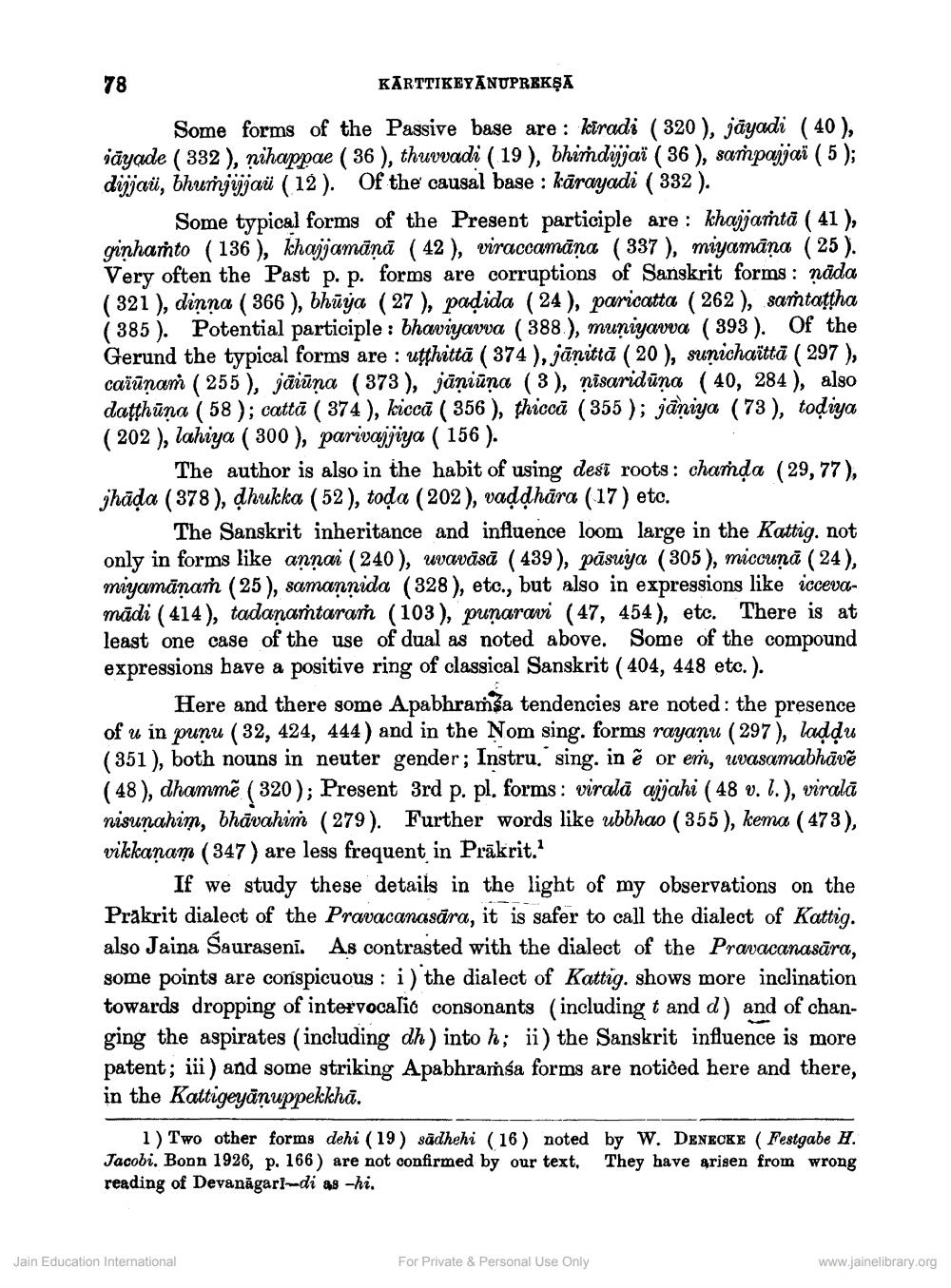________________
78
KĀRTTIKEYANUPREKŞA
Some forms of the Passive base are : kiradi ( 320 ), jāyadi ( 40 ), jāyade ( 332 ), nihappae ( 36 ), thuvvadi ( 19 ), bhimdijjaï ( 36 ), sampajjaï ( 5 ); dijjai, bhumjijjai (12). Of the causal base : kārayadi ( 332 ).
Some typical forms of the Present participle are : khajjartā ( 41 ), ginharto ( 136 ), khajjamānā ( 42 ), viraccamāna (337), miyamāņa ( 25 ). Very often the Past p. p. forms are corruptions of Sanskrit forms: näda ( 321 ), dinna ( 366 ), bhūya (27), padida (24), paricatta ( 262 ), sartațiha (385). Potential participle : bhaviyavva ( 388 ), muniyavva (393). Of the Gerund the typical forms are : utthitta ( 374 ), jānitta ( 20 ), sunichaïtta ( 297 ), caïūnan ( 255 ), jāiūna (373), jāņiūna (3), nīsaridūņa ( 40, 284), also daţthūna ( 58 ); cattā ( 374 ), kiccă ( 356 ), thiccā ( 355 ); jāniya (73), todiya (202), lahiya ( 300 ), parivajjiya ( 156 ).
The author is also in the habit of using desi roots : chamda (29,77), jhāda (378), dhukka (52), toda (202), vaddhāra (17) etc.
The Sanskrit inheritance and influence loom large in the Kattig. not only in forms like annai (240), uvavāsā (439), pāsuya (305), miccunā (24), miyamānam (25), samannida (328), etc., but also in expressions like iccevamādi (414), tadanaṁtarar (103), punaravi (47, 454 ), etc. There is at least one case of the use of dual as noted above. Some of the compound expressions have a positive ring of classical Sanskrit ( 404, 448 etc.).
Here and there some Apabhramša tendencies are noted: the presence of u in punu (32, 424, 444) and in the Nom sing. forms rayanu (297), laddu (351), both nouns in neuter gender; Instru. sing. in ě or em, uvasamabhāvē (48), dhammē. (320); Present 3rd p. pl. forms: viralā ajjahi ( 48 v. l.), viralā nisunahim, bhāvahiṁ (279). Further words like ubbhao (355), kema ( 473), vikkanam (347) are less frequent in Präkrit.
If we study these details in the light of my observations on the Prakrit dialect of the Pravacanasāra, it is safer to call the dialect of Kattig. also Jaina Saurasenī. As contrasted with the dialect of the Pravacanasāra, some points are conspicuous : i) the dialect of Kattig. shows more inclination towards dropping of intervocalit consonants (including t and d) and of changing the aspirates (including dh) into h; ii) the Sanskrit influence is more patent; iii) and some striking Apabhraṁsa forms are noticed here and there, in the Kattigeyānuppekkhā.
1) Two other forms dehi (19) sādhehi (16) noted by W. DENECKE ( Festgabe H. Jacobi. Bonn 1926, p. 166) are not confirmed by our text. They have arisen from wrong reading of Devanāgari-di as -hi.
Jain Education International
For Private & Personal Use Only
www.jainelibrary.org




